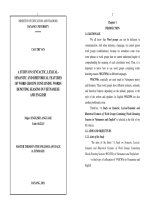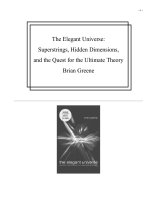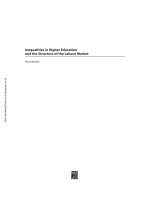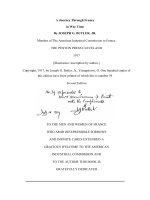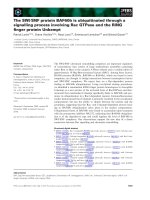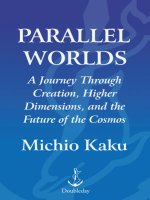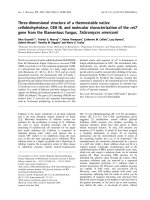- Trang chủ >>
- Khoa Học Tự Nhiên >>
- Vật lý
Parallel Worlds: A Journey Through Creation, Higher Dimensions, and the Future of the Cosmos
Bạn đang xem bản rút gọn của tài liệu. Xem và tải ngay bản đầy đủ của tài liệu tại đây (2.11 MB, 447 trang )
PARALLEL
WORLDS
Kaku_0385509863_4p_all_r1.qxd 10/27/04 7:07 AM Page i
Kaku_0385509863_4p_all_r1.qxd 10/27/04 7:07 AM Page ii
This book has been optimized for viewing
at a monitor setting of 1024 x 768 pixels.
Also by Michio Kaku
Beyond Einstein
Hyperspace
Visions
Einstein’s Cosmos
Kaku_0385509863_4p_all_r1.qxd 10/27/04 7:07 AM Page iii
MICHIO KAKU
DOUBLEDAY
New York London Toronto Sydney Auckland
Kaku_0385509863_4p_all_r1.qxd 10/27/04 7:07 AM Page iv
PARALLEL
WORLDS
A JOURNEY THROUGH
CREATION, HIGHER DIMENSIONS,
AND THE FUTURE OF THE COSMOS
Kaku_0385509863_4p_all_r1.qxd 10/27/04 7:07 AM Page v
published by doubleday
a division of Random House, Inc.
doubleday and the portrayal of an anchor with a dolphin are regis-
tered trademarks of Random House, Inc.
Book design by Nicola Ferguson
Illustrations by Hadel Studio
Library of Congress Cataloging-in-Publication Data
Kaku, Michio.
Parallel worlds : a journey through creation, higher dimensions,
and the future of the cosmos/Michio Kaku.—1st ed.
p. cm.
Includes bibliographical references
1. Cosmology. 2. Big bang theory. 3. Superstring theories.
4. Supergravity. I. Title.
QB981.K134 2004
523.1—dc22
2004056039
eISBN 0-385-51416-6
Copyright © 2005 Michio Kaku
All Rights Reserved
v1.0
Kaku_0385509863_4p_all_r1.qxd 10/27/04 7:07 AM Page vi
This book is dedicated to my loving wife, Shizue.
Kaku_0385509863_4p_all_r1.qxd 10/27/04 7:07 AM Page vii
Kaku_0385509863_4p_all_r1.qxd 10/27/04 7:07 AM Page viii
CONTENTS
acknowledgments xi
preface xv
PART I: THE UNIVERSE
chapter
one: Baby Pictures of the Universe 3
chapter two: The Paradoxical Universe 22
chapter three: The Big Bang
45
chapter four: Inflation and Parallel Universes 76
PART II: THE MULTIVERSE
chapter five:
Dimensional Portals and Time Travel 111
chapter six: Parallel Quantum Universes 146
chapter seven: M-Theory: The Mother of All Strings 181
chapter eight: A Designer Universe? 241
chapter nine: Searching for Echoes from
the Eleventh Dimension
256
PART III: ESCAPE INTO HYPERSPACE
chapter ten: The End of Everything 287
chapter eleven: Escaping the Universe 304
chapter twelve: Beyond the Multiverse 343
notes 363
glossary 381
recommended reading 403
index 407
Kaku_0385509863_4p_all_r1.qxd 10/27/04 7:07 AM Page ix
Kaku_0385509863_4p_all_r1.qxd 10/27/04 7:07 AM Page x
ACKNOWLEDGMENTS
I would like to thank the following scientists who were so gracious
in donating their time to be interviewed. Their comments, observa-
tions, and ideas have greatly enriched this book and added to its
depth and focus:
• Steven Weinberg, Nobel laureate, University of Texas at Austin
• Murray Gell-Mann, Nobel laureate, Santa Fe Institute and
California Institute of Technology
• Leon Lederman, Nobel laureate, Illinois Institute of Technology
• Joseph Rotblat, Nobel laureate, St. Bartholomew’s Hospital (re-
tired)
• Walter Gilbert, Nobel laureate, Harvard University
• Henry Kendall, Nobel laureate, Massachusetts Institute of
Technology (deceased)
• Alan Guth, physicist, Massachusetts Institute of Technology
• Sir Martin Rees, Astronomer Royal of Great Britain, Cambridge
University
• Freeman Dyson, physicist, Institute for Advanced Study,
Princeton University
• John Schwarz, physicist, California Institute of Technology
• Lisa Randall, physicist, Harvard University
• J. Richard Gott III, physicist, Princeton University
• Neil de Grasse Tyson, astronomer, Princeton University and
Hayden Planetarium
• Paul Davies, physicist, University of Adelaide
• Ken Croswell, astronomer, University of California, Berkeley
• Don Goldsmith, astronomer, University of California, Berkeley
• Brian Greene, physicist, Columbia University
Kaku_0385509863_4p_all_r1.qxd 10/27/04 7:07 AM Page xi
• Cumrun Vafa, physicist, Harvard University
• Stuart Samuel, physicist, University of California, Berkeley
• Carl Sagan, astronomer, Cornell University (deceased)
• Daniel Greenberger, physicist, City College of New York
• V. P. Nair, physicist, City College of New York
• Robert P. Kirshner, astronomer, Harvard University
• Peter D. Ward, geologist, University of Washington
• John Barrow, astronomer, University of Sussex
• Marcia Bartusiak, science journalist, Massachusetts Institute
of Technology
• John Casti, physicist, Santa Fe Institute
• Timothy Ferris, science journalist
• Michael Lemonick, science writer, Time magazine
• Fulvio Melia, astronomer, University of Arizona
• John Horgan, science journalist
• Richard Muller, physicist, University of California, Berkeley
• Lawrence Krauss, physicist, Case Western Reserve University
• Ted Taylor, atomic bomb designer
• Philip Morrison, physicist, Massachusetts Institute of Tech-
nology
• Hans Moravec, computer scientist, Carnegie Mellon University
• Rodney Brooks, computer scientist, Artificial Intelligence
Laboratory, Massachusetts Institute of Technology
• Donna Shirley, astrophysicist, Jet Propulsion Laboratory
• Dan Wertheimer, astronomer, SETI@home, University of
California, Berkeley
• Paul Hoffman, science journalist, Discover magazine
• Francis Everitt, physicist, Gravity Probe B, Stanford University
• Sidney Perkowitz, physicist, Emory University
I would also like to thank the following scientists for stimulating
discussions about physics over the years that have greatly helped to
sharpen the content of this book:
• T. D. Lee, Nobel laureate, Columbia University
• Sheldon Glashow, Nobel laureate, Harvard University
xii ACKNOWLEDGMENTS
Kaku_0385509863_4p_all_r1.qxd 10/27/04 7:07 AM Page xii
• Richard Feynman, Nobel laureate, California Institute of Tech-
nology (deceased)
• Edward Witten, physicist, Institute for Advanced Study,
Princeton University
• Joseph Lykken, physicist, Fermilab
• David Gross, physicist, Kavli Institute, Santa Barbara
• Frank Wilczek, physicist, University of California, Santa Barbara
• Paul Townsend, physicist, Cambridge University
• Peter Van Nieuwenhuizen, physicist, State University of New
York, Stony Brook
• Miguel Virasoro, physicist, University of Rome
• Bunji Sakita, physicist, City College of New York (deceased)
• Ashok Das, physicist, University of Rochester
• Robert Marshak, physicist, City College of New York (deceased)
• Frank Tipler, physicist, Tulane University
• Edward Tryon, physicist, Hunter College
• Mitchell Begelman, astronomer, University of Colorado
I would like to thank Ken Croswell for numerous comments on
the book.
I would also like to thank my editor, Roger Scholl, who has mas-
terfully edited two of my books. His sure hand has greatly enhanced
the books, and his comments have always helped to clarify and
deepen the content and presentation of my books. Last, I would like
to thank my agent, Stuart Krichevsky, who has ushered in my books
for all these years.
ACKNOWLEDGMENTS xiii
Kaku_0385509863_4p_all_r1.qxd 10/27/04 7:07 AM Page xiii
Kaku_0385509863_4p_all_r1.qxd 10/27/04 7:07 AM Page xiv
PREFACE
Cosmology is the study of the universe as a whole, including its birth
and perhaps its ultimate fate. Not surprisingly, it has undergone
many transformations in its slow, painful evolution, an evolution of-
ten overshadowed by religious dogma and superstition.
The first revolution in cosmology was ushered in by the intro-
duction of the telescope in the 1600s. With the aid of the telescope,
Galileo Galilei, building on the work of the great astronomers
Nicolaus Copernicus and Johannes Kepler, was able to open up the
splendor of the heavens for the first time to serious scientific inves-
tigation. The advancement of this first stage of cosmology culmi-
nated in the work of Isaac Newton, who finally laid down the
fundamental laws governing the motion of the celestial bodies.
Instead of magic and mysticism, the laws of heavenly bodies were
now seen to be subject to forces that were computable and repro-
ducible.
A second revolution in cosmology was initiated by the introduc-
tion of the great telescopes of the twentieth century, such as the one
at Mount Wilson with its huge 100-inch reflecting mirror. In the
1920s, astronomer Edwin Hubble used this giant telescope to over-
turn centuries of dogma, which stated that the universe was static
and eternal, by demonstrating that the galaxies in the heavens are
moving away from the earth at tremendous velocities—that is, the
universe is expanding. This confirmed the results of Einstein’s the-
ory of general relativity, in which the architecture of space-time, in-
stead of being flat and linear, is dynamic and curved. This gave the
first plausible explanation of the origin of the universe, that the
universe began with a cataclysmic explosion called the “big bang,”
Kaku_0385509863_4p_all_r1.qxd 10/27/04 7:07 AM Page xv
which sent the stars and galaxies hurtling outward in space. With
the pioneering work of George Gamow and his colleagues on the big
bang theory and Fred Hoyle on the origin of the elements, a scaf-
folding was emerging giving the broad outlines of the evolution of
the universe.
A third revolution is now under way. It is only about five years
old. It has been ushered in by a battery of new, high-tech instru-
ments, such as space satellites, lasers, gravity wave detectors, X-ray
telescopes, and high-speed supercomputers. We now have the most
authoritative data yet on the nature of the universe, including its
age, its composition, and perhaps even its future and eventual
death.
Astronomers now realize that the universe is expanding in a run-
away mode, accelerating without limit, becoming colder and colder
with time. If this continues, we face the prospect of the “big freeze,”
when the universe is plunged into darkness and cold, and all intel-
ligent life dies out.
This book is about this third great revolution. It differs from my
earlier books on physics, Beyond Einstein and Hyperspace, which helped
to introduce to the public the new concepts of higher dimensions
and superstring theory. In Parallel Worlds, instead of focusing on
space-time, I concentrate on the revolutionary developments in cos-
mology unfolding within the last several years, based on new evi-
dence from the world’s laboratories and the outermost reaches of
space, and new breakthroughs in theoretical physics. It is my inten-
tion that it can be read and grasped without any previous introduc-
tion to physics or cosmology.
In part 1 of the book, I focus on the study of the universe, sum-
marizing the advances made in the early stages of cosmology, culmi-
nating in the theory called “inflation,” which gives us the most
advanced formulation to date of the big bang theory. In part 2, I fo-
cus specifically on the emerging theory of the multiverse—a world
made up of multiple universes, of which ours is but one—and dis-
cuss the possibility of wormholes, space and time warps, and how
higher dimensions might connect them. Superstring theory and
M-theory have given us the first major step beyond Einstein’s origi-
xvi PREFACE
Kaku_0385509863_4p_all_r1.qxd 10/27/04 7:07 AM Page xvi
nal theory; they give further evidence that our universe may be but
one of many. Finally, in part 3, I discuss the big freeze and what sci-
entists now see as the end of our universe. I also give a serious,
though speculative, discussion of how an advanced civilization in
the distant future might use the laws of physics to leave our uni-
verse trillions of years from now and enter another, more hospitable
universe to begin the process of rebirth, or to go back in time when
the universe was warmer.
With the flood of new data we are receiving today, with new tools
such as space satellites which can scan the heavens, with new grav-
ity wave detectors, and with new city-size atom smashers nearing
completion, physicists feel that we are entering what may be the
golden age of cosmology. It is, in short, a great time to be a physicist
and a voyager on this quest to understand our origins and the fate of
the universe.
PREFACE xvii
Kaku_0385509863_4p_all_r1.qxd 10/27/04 7:07 AM Page xvii
Kaku_0385509863_4p_all_r1.qxd 10/27/04 7:07 AM Page xviii
PART
ONE
THE UNIVERSE
Kaku_0385509863_4p_all_r1.qxd 10/27/04 7:07 AM Page 1
Kaku_0385509863_4p_all_r1.qxd 10/27/04 7:07 AM Page 2
CHAPTER ONE
Baby Pictures of the Universe
The poet only asks to get his head into the heavens. It is
the logician who seeks to get the heavens into his head.
And it is his head that splits.
—G. K. Chesterson
W
hen I was a child, I had a personal conflict over my beliefs. My
parents were raised in the Buddhist tradition. But I attended
Sunday school every week, where I loved hearing the biblical stories
about whales, arks, pillars of salt, ribs, and apples. I was fascinated
by these Old Testament parables, which were my favorite part of
Sunday school. It seemed to me that the parables about great floods,
burning bushes, and parting waters were so much more exciting
than Buddhist chanting and meditation. In fact, these ancient tales
of heroism and tragedy vividly illustrated deep moral and ethical
lessons which have stayed with me all my life.
One day in Sunday school we studied Genesis. To read about God
thundering from the heavens, “Let there be Light!” sounded so much
more dramatic than silently meditating about Nirvana. Out of naïve
curiosity, I asked my Sunday school teacher, “Did God have a
mother?” She usually had a snappy answer, as well as a deep moral
lesson to offer. This time, however, she was taken aback. No, she
replied hesitantly, God probably did not have a mother. “But then
Kaku_0385509863_4p_all_r1.qxd 10/27/04 7:07 AM Page 3
where did God come from?” I asked. She mumbled that she would
have to consult with the minister about that question.
I didn’t realize that I had accidentally stumbled on one of the
great questions of theology. I was puzzled, because in Buddhism,
there is no God at all, but a timeless universe with no beginning or
end. Later, when I began to study the great mythologies of the world,
I learned that there were two types of cosmologies in religion, the
first based on a single moment when God created the universe, the
second based on the idea that the universe always was and always
will be.
They couldn’t both be right, I thought.
Later, I began to find that these common themes cut across many
other cultures. In Chinese mythology, for example, in the beginning
there was the cosmic egg. The infant god P’an Ku resided for almost
an eternity inside the egg, which floated on a formless sea of Chaos.
When it finally hatched, P’an Ku grew enormously, over ten feet per
day, so the top half of the eggshell became the sky and the bottom
half the earth. After 18,000 years, he died to give birth to our world:
his blood became the rivers, his eyes the sun and moon, and his voice
the thunder.
In many ways, the P’an Ku myth mirrors a theme found in many
other religions and ancient mythologies, that the universe sprang
into existence creatio ex nihilo (created from nothing). In Greek
mythology, the universe started off in a state of Chaos (in fact, the
word “chaos” comes from the Greek word meaning “abyss”). This fea-
tureless void is often described as an ocean, as in Babylonian and
Japanese mythology. This theme is found in ancient Egyptian
mythology, where the sun god Ra emerged from a floating egg. In
Polynesian mythology, the cosmic egg is replaced by a coconut shell.
The Mayans believed in a variation of this story, in which the uni-
verse is born but eventually dies after five thousand years, only to be
resurrected again and again to repeat the unending cycle of birth
and destruction.
These creatio ex nihilo myths stand in marked contrast to the cos-
mology according to Buddhism and certain forms of Hinduism. In
these mythologies, the universe is timeless, with no beginning or
4 Michio Kaku
Kaku_0385509863_4p_all_r1.qxd 10/27/04 7:07 AM Page 4
end. There are many levels of existence, but the highest is Nirvana,
which is eternal and can be attained only by the purest meditation.
In the Hindu Mahapurana, it is written, “If God created the world,
where was He before Creation? . . . Know that the world is uncre-
ated, as time itself is, without beginning and end.”
These mythologies stand in marked contradiction to each other,
with no apparent resolution between them. They are mutually ex-
clusive: either the universe had a beginning or it didn’t. There is, ap-
parently, no middle ground.
Today, however, a resolution seems to be emerging from an en-
tirely new direction—the world of science—as the result of a new
generation of powerful scientific instruments soaring through outer
space. Ancient mythology relied upon the wisdom of storytellers to
expound on the origins of our world. Today, scientists are unleash-
ing a battery of space satellites, lasers, gravity wave detectors, inter-
ferometers, high-speed supercomputers, and the Internet, in the
process revolutionizing our understanding of the universe, and giv-
ing us the most compelling description yet of its creation.
What is gradually emerging from the data is a grand synthesis
of these two opposing mythologies. Perhaps, scientists speculate,
Genesis occurs repeatedly in a timeless ocean of Nirvana. In this
new picture, our universe may be compared to a bubble floating in
a much larger “ocean,” with new bubbles forming all the time.
According to this theory, universes, like bubbles forming in boiling
water, are in continual creation, floating in a much larger arena, the
Nirvana of eleven-dimensional hyperspace. A growing number of
physicists suggest that our universe did indeed spring forth from a
fiery cataclysm, the big bang, but that it also coexists in an eternal
ocean of other universes. If we are right, big bangs are taking place
even as you read this sentence.
Physicists and astronomers around the world are now speculat-
ing about what these parallel worlds may look like, what laws they
may obey, how they are born, and how they may eventually die.
Perhaps these parallel worlds are barren, without the basic ingredi-
ents of life. Or perhaps they look just like our universe, separated by
a single quantum event that made these universes diverge from
PARALLEL WORLDS 5
Kaku_0385509863_4p_all_r1.qxd 10/27/04 7:07 AM Page 5
ours. And a few physicists are speculating that perhaps one day, if
life becomes untenable in our present universe as it ages and grows
cold, we may be forced to leave it and escape to another universe.
The engine driving these new theories is the massive flood of data
that is pouring from our space satellites as they photograph rem-
nants of creation itself. Remarkably, scientists are now zeroing in on
what happened a mere 380,000 years after the big bang, when the
“afterglow” of creation first filled the universe. Perhaps the most
compelling picture of this radiation from creation is coming from a
new instrument called the WMAP satellite.
THE WMAP SATELLITE
“Incredible!” “A milestone!” were among the words uttered in
February 2003 by normally reserved astrophysicists as they de-
scribed the precious data harvested from their latest satellite. The
WMAP (Wilkinson microwave anisotropy probe), named after pio-
neering cosmologist David Wilkinson and launched in 2001, has
given scientists, with unprecedented precision, a detailed picture of
the early universe when it was a mere 380,000 years old. The colos-
sal energy left over from the original fireball that gave birth to stars
and galaxies has been circulating around our universe for billions of
years. Today, it has finally been captured on film in exquisite detail
by the WMAP satellite, yielding a map never seen before, a photo of
the sky showing with breathtaking detail the microwave radiation
created by the big bang itself, what has been called the “echo of cre-
ation” by Time magazine. Never again will astronomers look at the
sky in the same way again.
The findings of the WMAP satellite represent “a rite of passage
for cosmology from speculation to precision science,” declared John
Bahcall of the Institute for Advanced Study at Princeton. For the
first time, this deluge of data from this early period in the history of
the universe has allowed cosmologists to answer precisely the most
ancient of all questions, questions that have puzzled and intrigued
humanity since we first gazed at the blazing celestial beauty of the
6 Michio Kaku
Kaku_0385509863_4p_all_r1.qxd 10/27/04 7:07 AM Page 6
